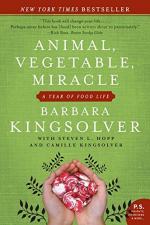|
This section contains 1,181 words (approx. 3 pages at 400 words per page) |

|
Summary
In Chapter 4, “Stalking the Vegetannual,” Barbara points out that most vegetables are flowering plants. The exceptions are seaweed, mushrooms, and pinenuts. She tells the reader to think of all garden produce as one plant that she called the “vegetannual.” It would send up edible shoots in the early spring, then leaves, flowers, and small green fruits that ripen. The final stages are hard-shelled fruits, and finally roots and tubers. She then compares those stages to the actual foods available to her family in their region, beginning with spinach, kale, lettuce and chard in the spring followed by broccoli, cabbage, cauliflower, and romaine. The early peas, baby squash, and cucumbers are next with green beans, peppers, and tomatoes by July. The “hard shell” produce included cantaloupes, melons, pumpkins, and winter squash, with the root crops wrapping up the year.
Barbara again addresses the need...
(read more from the Chapters 4-6 Summary)
|
This section contains 1,181 words (approx. 3 pages at 400 words per page) |

|




